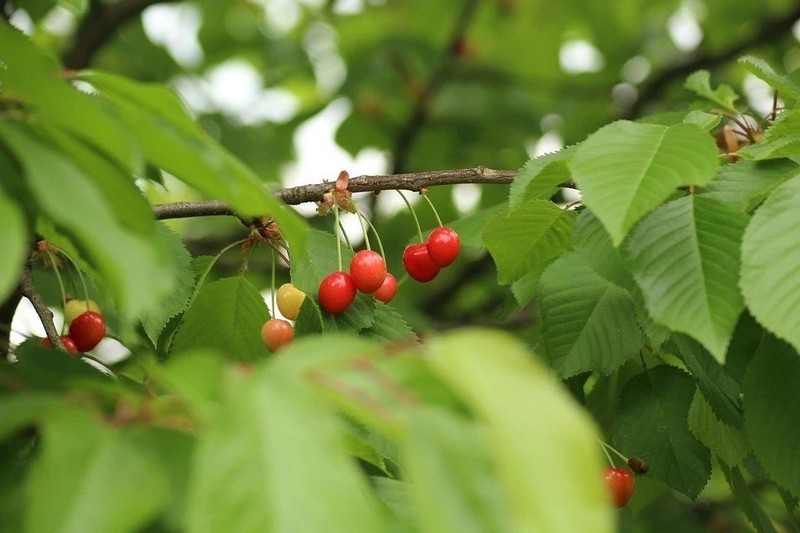Pest Control Case Study — Cherry Trees
As a valuable plant with tremendous economic benefits, cherry trees mature early and produce abundant fruit. However, they are often exposed to a variety of pests and diseases, with their trunks, foliage, flowers, and fruits susceptible to pests and germs. Therefore, learning how to repel these threats efficiently is something that must be seriously considered as the growing season continues.

Spraying Team Introduction
Dalian Yitian Aviation Technology Co., Ltd has five core members, two agricultural technicians, and several drone pilots and ground staff members. The company has cooperated with more than 30 drone pilots and has established the Yitian Spray Alliance (YSA). The team provides dedicated spraying plans for a variety of different plants, such as wheat, rice, corn, soybeans, peanuts, green onions, horseradish, cherries, apples, filbert, and other gardening plants. Today, their total spraying area covers over 4.2 million acres of land (1.74 million hectares).
Dalian is home to over 2.4 million acres of cherry trees, which requires at least nine spraying operations each year. Realizing this, YSA reached out to farmers for cooperation. Initially, the local community was skeptical of YSA’s services. Most stated that “a cherry tree is about 4 meters high, and since its leaves are often thick, spraying should be done by hand, not drones.”

To alleviate these doubts, YSA staff member Liu Hongyu contacted Ye Hang, who has sprayed more than 47,000 acres of cherry trees in Shaanxi. After much consultation, Liu Hongyu sprayed 13 acres of cherry trees as a way of demonstrating the value of drone technology for pest control. The farmers were convinced and placed an order for an additional 2,000 acres to be sprayed. Below is an overview of how this order was fulfilled.
Environment Information
|
Operating Date |
2018.05.19 |
Location |
Dalian, Shandong, China |
|
Terrain Type |
Hill |
Temperature and Wind |
Lv. 3 South Wind |
Operation Parameters
|
Operation Mode |
Route Operation |
Flight Speed |
3.1 m/s |
|
Flight Altitude |
1.5 m |
Route Spacing |
5 m |
|
Volume per hectare |
0.1 L |
Nozzle Type |
Fan-shaped nozzle |
Before spraying begins, it is important to determine the spacing of the rows of cherry trees. Since cherry trees are often planted relatively far from each other, typical spacing between rows is about 5 m. Consequently, agriculture drones must fly above each row while spraying to maximize the use of pesticides.
Pesticide Information
|
Pesticide Name |
Dosage Form |
Effective Composition and Content |
Dosage/ha |
|
Lambda-cyhalothrin |
Microemulsion |
2.5% |
3.35 ml |
|
Zineb |
Dissolvable Powder |
65% |
4.69 g |
|
Triflumizole, Trifloxystrobin |
Suspension Concentrate |
42.8% |
2.01 ml |
|
Spreader |
Emulsifiable Concentrate |
- |
1.68 ml |
* Dissolvable powder was used in this case. Next time, communicate with farmers in advance and try to avoid such agents, as they might block the spray system and affect the spraying results.

These pesticides were provided by farmers for pest control and should be mixed according to the directions printed on the label. After the Route Operation has finished, remember to fly the drone along the edges of the field and spray the trees there as well.
Effect of spraying

Leaves seriously harmed by pests (L) Leaves with droplets evenly sprayed on (R)
After spraying, farmers physically examined the field to obtain relevant results. Since the Zineb used that day was blue (by containing blue vitriol), it was easy for them to see that the droplets were evenly and densely sprayed all over the leaves.
Conclusion
Farmers were delighted with the spraying result and said they would continue using the T16 for spraying in the future. Throughout this operation, we discovered the best weather for spraying cherry trees is in a windless setting, or when wind speed is under 3 m/s. Route Operation mode is recommended to avoid repetition or omission in spraying. It is also recommended to turn off the high-precision terrain detection radar, and use the barometer to set the height. Remember to fly the drone at a height of approximately 1.5 m over the crops, and since some plants are four or five meters high, pilots need to fine-tune when necessary.
Related Articles
Can DJI AGRAS T16 eradicate citrus red mites? Let the facts speak for themselves.
Agricultural Drones Fly Over Brazil to Help Soybean Farmers Prevent Diseases and Increase Production
Aerial Application of Cotton Defoliant